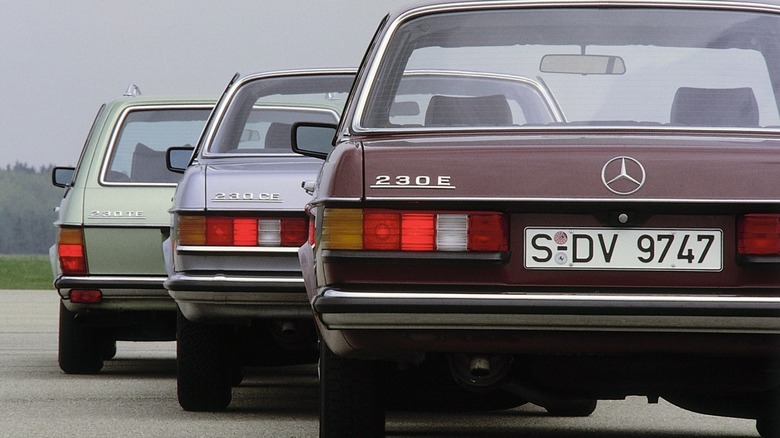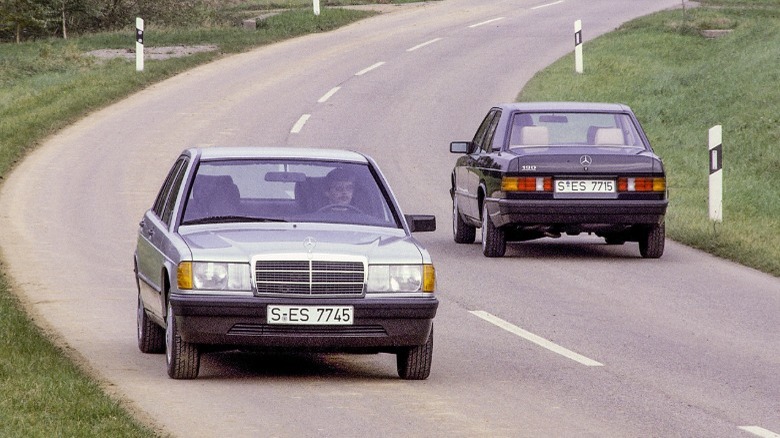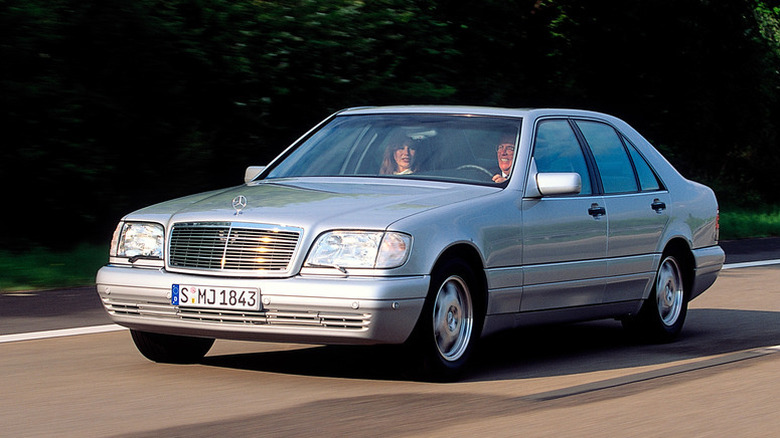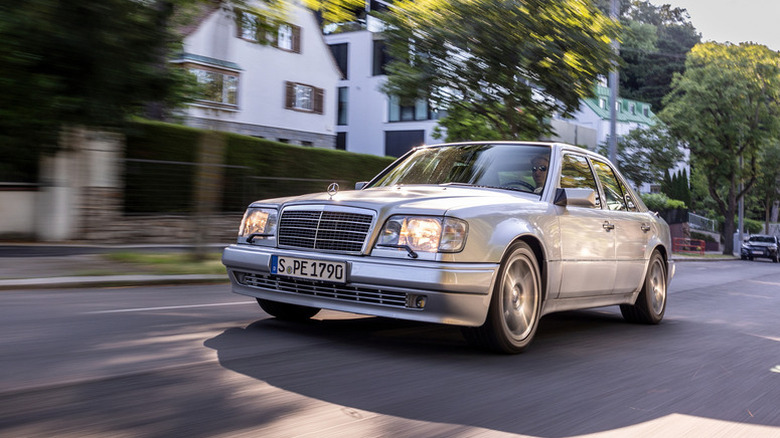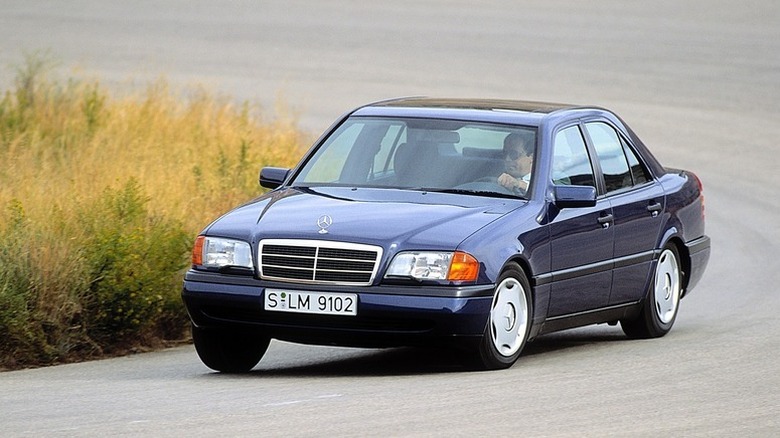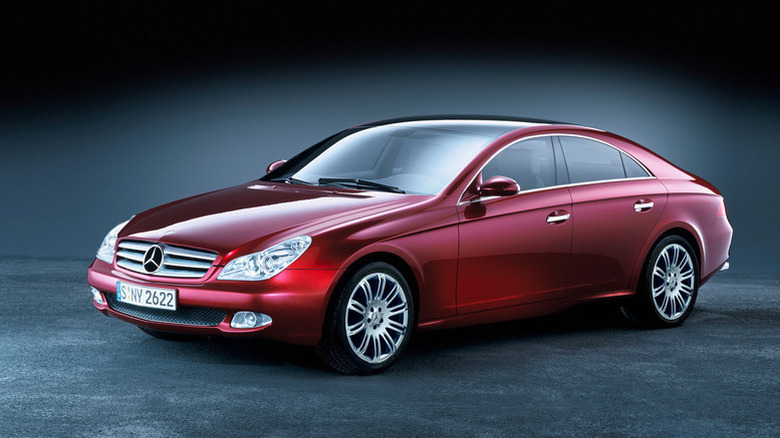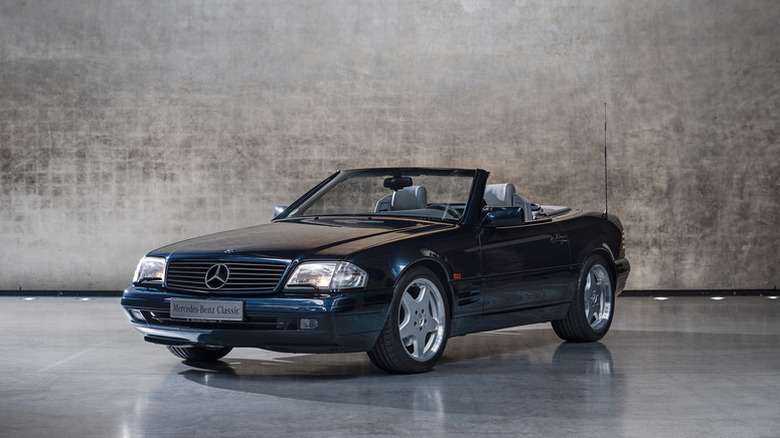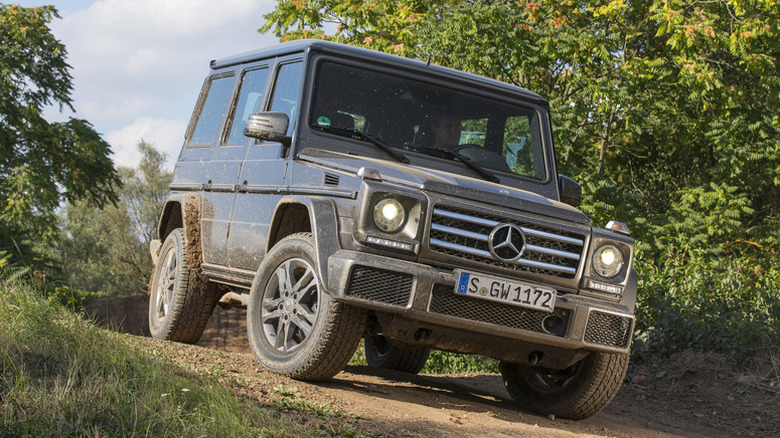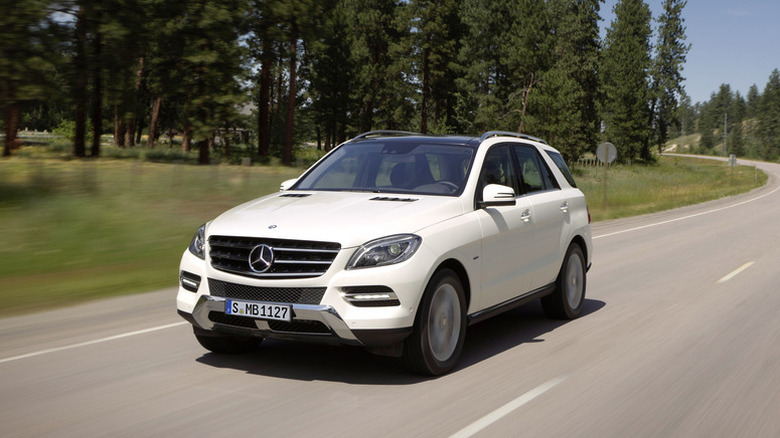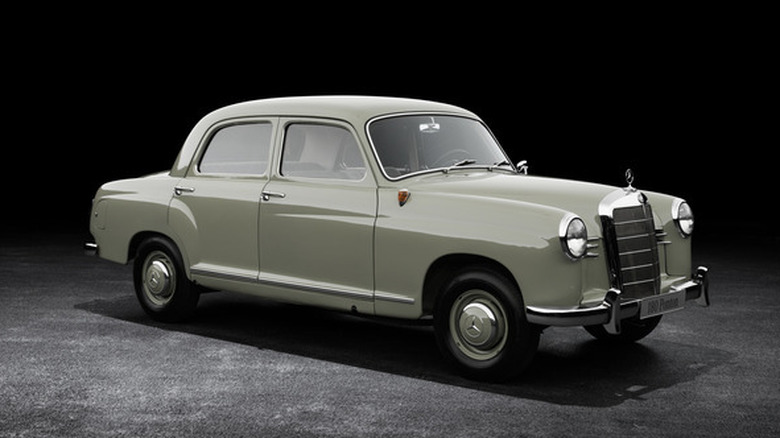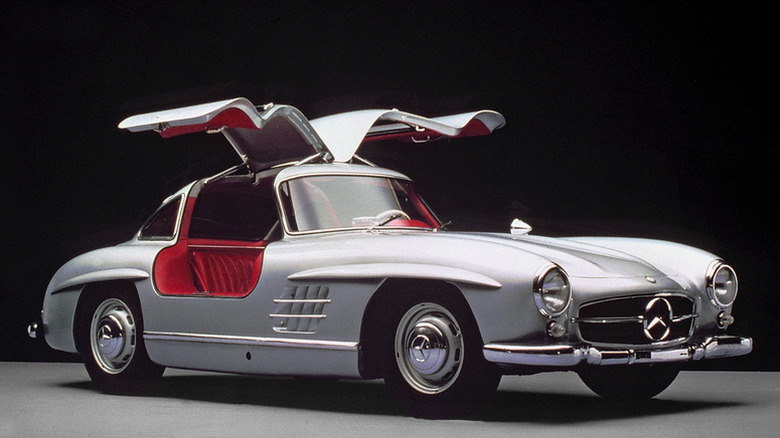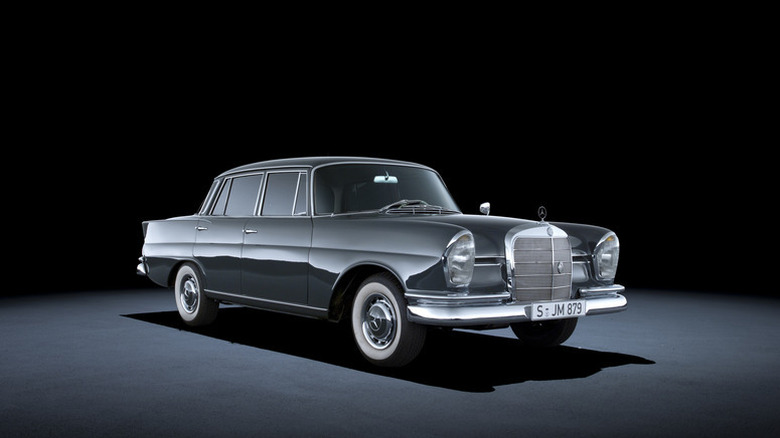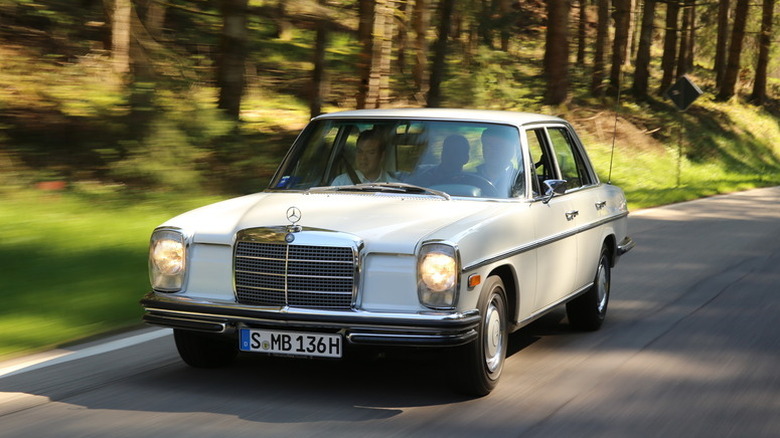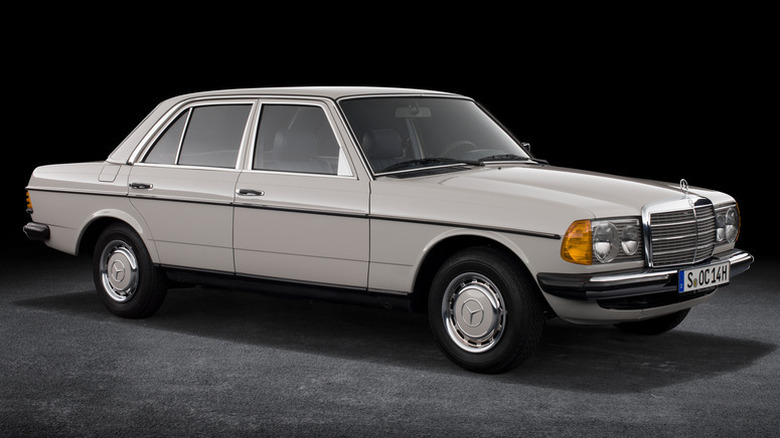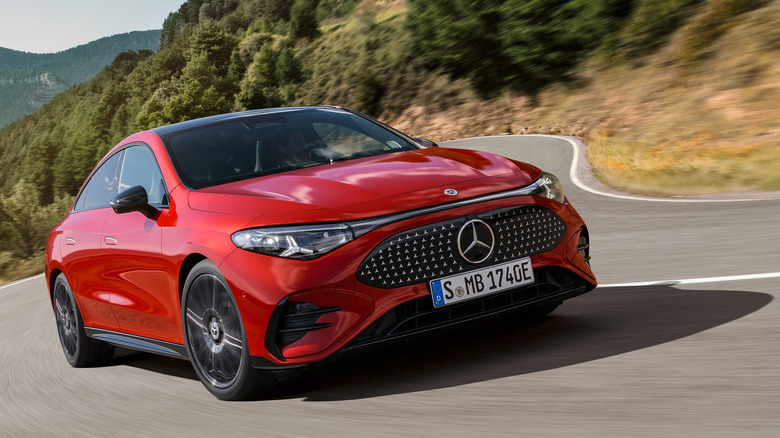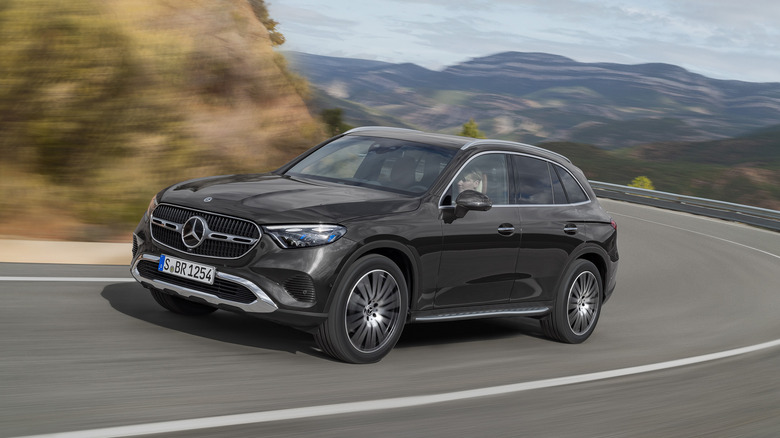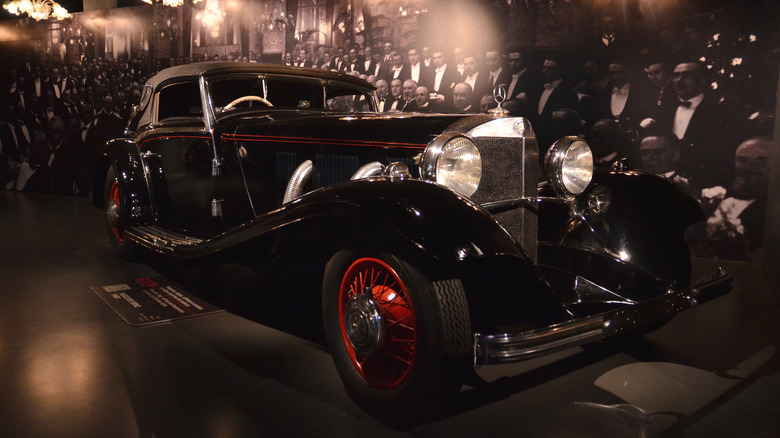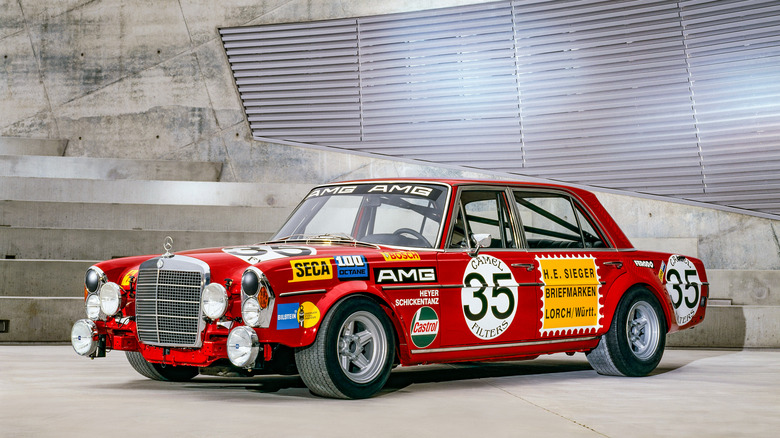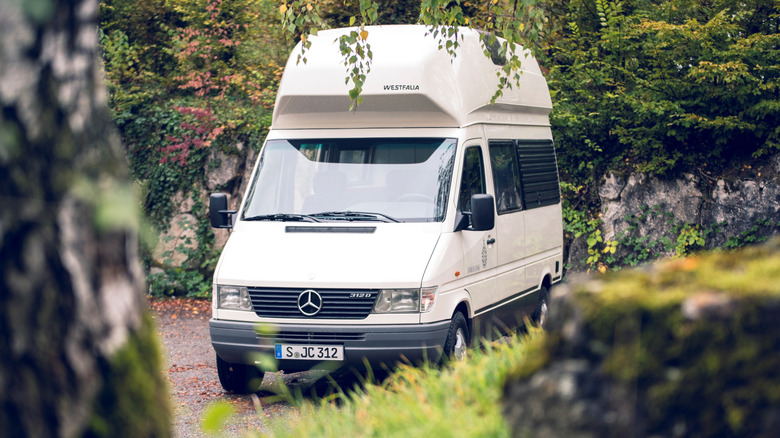18 Of The Most Successful Models In Mercedes-Benz History
Mercedes-Benz was founded as a company in 1926, but its story has roots in the first-ever automobile, the Benz Patent Motor Car. Namely, one of the company's founders, Karl Benz, created that car, spawning one of the most successful global industries. Consequently, Mercedes-Benz became sort of the quintessential car manufacturer, quickly leapfrogging the competition that was already established in the 1920s, like Rolls-Royce, Bentley, Duesenberg, Ford, Chrysler, Cadillac, and Packard.
The main driving force behind the company's rise to the top of the automotive industry was innovation. From creating the first car to giving us crumple zones for higher safety during crashes, the engineers behind the company pushed the industry to ever higher levels. Even today, Mercedes-Benz remains one of the world's most innovative automakers, pushing the boundaries with advanced software and safety systems.
Crucially, though, Mercedes-Benz has always been a car-building company first, and high-tech features weren't the only draw. Vehicles from Mercedes-Benz cars have always been made to a high engineering standard, with a focus on performance, luxury, and durability.
In this article, we will take you on a fact-filled Mercedes-Benz journey, where we will revisit the company's most successful models in its history. These cars either pushed the industry boundaries or were a sales success. Either way, they helped to create one of the most successful automakers in history. Let's dive in!
Mercedes-Benz 190 (1982 to 1993)
The W201-chassis 190 might've been around for only one generation, with most people thinking of it as the precursor to the C-Class. Yes, the special, Cosworth-powered 190E 2.3-16 and later 2.5-15 Evo II deserve their place in history, but the regular model was even more important. Notably, it was the first Baby-Benz — a more affordable entry into the luxury world of Mercedes-Benz.
But the German automaker didn't cut corners to make the 190 more affordable. The car has undergone a very expensive development process, which has cost the company over $800 million. Crucially, it was designed to the standards of other Mercedes-Benz sedans. For instance, the 190 had a body designed by Bruno Sacco, boasting a drag coefficient of just 0.33 Cd. It had an advanced five-link rear suspension with self-leveling dampers, giving it better handling without sacrificing the traditional Mercedes-Benz comfort. Engine soundproofing was also part of the deal in the diesel variants, and the German automaker even implemented rust-proofing measures. This was a Merc through and through, albeit in a more condensed form.
The 190 was also available with many different engine options. Buyers could choose between four-cylinder and six-cylinder gas engines, and four-cylinder or five-cylinder diesel engines, each known for being durable and generally problem-free. They were economical, too, particularly the diesels, which were good for 38 mpg! With so many powertrain options, great handling and comfort, and excellent build quality, the 190 has proved highly successful, with Mercedes-Benz selling almost 1.9 million units in just 11 years.
Mercedes-Benz S-Class (1972 to 2024)
What better way to start the three-point-star voyage than with Mercedes' most advanced car, the S-Class? As the brand's flagship vehicle, the S-Class is the car where you'd see most of Mercedes' new innovations and advanced technologies. Still, most people bought it for its impeccable build quality, smooth ride, and luxurious cabin.
It all started with the first S-Class W116, which was launched in 1972 to outdo the Rolls-Royce Silver Shadow in most aspects, particularly the high-end 6.9 SEL model. As a result, the S-Class received the European Car of the Year accolade in 1974 and was a huge sales success, with over 475,000 models sold during its eight-year lifespan. The second-gen S-Class W126, launched in 1978, continued with the high-tech, high-luxury formula. It was also one of the first cars with ABS and airbags, which have become staple safety features in every modern road-going vehicle.
The third-gen S-Class W140 was another huge leap forward and remains one of the most sought-after generations. It was a technological tour-de-force, too, bringing features like ESP (Electronic Stability Program), color navigation with LINGUATRONIC voice operation, and PARKTRONIC parking assistance system. Meanwhile, the fourth-gen W220 was the first car with Mercedes' DISTRONIC adaptive cruise control, while the W221 generation brought Night View Assist.
In 2023, Mercedes made another huge leap forward with the W222, which had a Magic Body Control that scanned the road ahead to maximize road comfort. The last W223 S-Class, launched in 2021, still sits at the pinnacle of the luxury car hierarchy, providing unprecedented levels of opulence.
Mercedes-Benz E-Class (1984 to 2024)
The E-Class has been the executive car of choice ever since the first model arrived in 1984. It was often the first Mercedes-Benz model to receive the high-tech features of the S-Class but with slightly less opulence. As a result, the E-Class has always been popular with private and fleet customers worldwide. In Europe, it's also hugely popular as a taxi vehicle, thanks to the focus on comfort, reliability, and efficiency.
The first-gen W124, named the E-Class only in 1993, was the model that set the nameplate for success using those qualities. Thanks to its aerodynamic body and numerous gas and diesel engines on offer, it was very efficient for an executive vehicle. Moreover, its steel body was sturdy while remaining relatively lightweight, enhancing efficiency. The W124 is also known to be very durable and reliable. The W210 E-Class — launched in 1995 –improved on the executive car formula with a completely new design with four circular headlights. The W210 also brought multiple advanced safety features, like ASR for traction control, ESP, and BAS (braking assist control).
In 2002, the W211 E-Class kept the four headlights but in a more elegant body, had aluminum front and rear axles, and air suspension. Meanwhile, the W212 model had a more angular design, with its streamlined body bringing the drag coefficient to 0.24. In 2016, the W213 brought a new design to the table, along with a semi-automated driving feature. Finally, the latest W214 E-Class has a screen galore inside and gives passengers a customarily serene ride.
Mercedes-Benz C-Class (1993 to 2024)
The C-Class was Mercedes-Benz's most attainable vehicle before the A-Class arrived on the scene. It has always used a rear-wheel-drive platform, offering its owners the true Mercedes-Benz experience, albeit in a more compact package. Mercedes-Benz's smallest RWD car traces its roots back to the W201 190 E compact sedan, which the company famously introduced as a response to the Clean Air Act in America. Most importantly, it gave us the 190 E 2.5-16 Evolution homologation car with a special naturally-aspirated 2.3-liter Cosworth engine.
The first official C-Class arrived in 1993 with the W202 generation, which was bigger inside, both for passengers and cargo. This time, Mercedes-Benz offered several performance versions in collaboration with AMG, like the C36, C43, and the V8-powered, 347 hp C55 AMG. In 2000, a brand-new C-Class arrived with a much more elegant design. For this W203 generation, Mercedes focused on advanced features, so its compact sedan was equipped with Apple iPod integration, headlight assist, and adaptive airbags.
In the subsequent W204 model, introduced in 2007, Mercedes-Benz improved the body rigidity and aerodynamics. This, along with the more modern engines, made the C-Class faster and better to drive — the C63 AMG performance model, in particular, was a rocket with its naturally aspirated V8. For the W205 generation, Mercedes-Benz focused mainly on luxury, with the C-Class sharing design elements with the S-Class and E-Class. The latest W206 C-Class, launched in 2021, doubled down on luxury and technology, borrowing the advanced MBUX system from the S-Class.
Mercedes-Benz CLS (2004 to 2023)
The four-door coupe body style, either in a low-slung sedan-like form or a raised SUV form, traces its roots to the CLS-Class. With this car, Mercedes-Benz showed its willingness to take risks, which ultimately paid off by bringing younger customers to the brand. The CLS was discontinued in 2023, but the four-door coupe idea lives on in the AMG 4-Door Coupe, which serves as a high-performance version.
The first-gen C219 CLS-Class was introduced in 2004 and shared the W211 platform with the E-Class. It was mostly the same vehicle underneath, with identical engines and wheelbase. However, whereas the E-Class was geared to a more luxury-oriented audience, the CLS-Class was for customers who valued style and performance. Notably, the CLS-Class had a smaller trunk, but it was much more attractive on the outside and even more luxurious inside.
The second-gen C218 model arrived with an even more elegant design. The CLS Shooting Brake with a 590-liter trunk was added, too, bringing more functionality to the svelte coupe. For the third and final generation, Mercedes-Benz gave us perhaps the most elegantly styled CLS, which looks like it was carved from one big piece of metal. It was very luxurious inside, too. However, the CLS 63 AMG model was replaced by the high-performance Mercedes-AMG GT 4-Door Coupe.
Mercedes-Benz SL-Class (1954 to 2024)
The SL-Class dates back to 1954 when Mercedes-Benz shocked the world with the 300 SL Gullwing — a car so advanced and influential that we'll revisit it later. Even so, all other SL-Class vehicles were handsome and fast convertibles designed for the buyer who required style, sophistication, and performance. Over the years, the SL-Class has earned a reputation for being a cool car that fits wealthy people's glamorous lifestyles.
Take the W113 model, launched in 1963, as an example. With its Pagoda-like removable hardtop and super-elegant design, the W113 SL still captures attention to this day. The 1971 R107 SL brought more muscular lines and more powerful engines. Still, the R129 model, launched in 1989, might be the most popular, with its slab-like minimalistic design still capturing attention today. In this generation, there was even an SL73 AMG variant with a 7.3-liter V12 behemoth producing 525 hp — enough for a brisk 0-62 mph time of 4.8 seconds.
What came next was the SL R230, which was the first in the line with a folding hardtop. It also gave us the SL65 AMG Black Series that had 670 hp and was significantly lighter than the regular model. For the R231 model introduced in 2012, Mercedes-Benz went with an ever-more elegant design. The latest R232 model saw the biggest changes, as it's AWD-only and has a 2+2 seating layout, though we still think it deserves its SL badge.
Mercedes-Benz G-Class (1979 to 2024)
Much like the Jeep Willys in the U.S. and the Toyota Land Cruiser in Japan, the G-Class was conceived as a German military vehicle. However, it is much more famous today for its off-road credentials and rugged looks, which have gone essentially unchanged since its introduction. The first model, introduced in 1979, had a particular off-road focus thanks to its narrow body and locking differentials. As such, it was more popular as a professional vehicle, though civilian models weren't uncommon.
Still, the W463 model, launched in 1989, brought the G-Wagen closer to the general audience, introducing a more luxurious cabin with leather and wood that brought it in line with other Mercedes-Benz vehicles of the era. The G-Class didn't lose its tough image and off-road prowess, but many customers never veered off the beaten path, instead simply buying the G-Class for its tough image.
The W463 generation was sold with a few changes until 2018 when Mercedes-Benz finally introduced the brand-new second-gen W463 model. The new G-Class was based on an entirely new platform, which brought a much more sophisticated ride and even better off-road abilities. Even so, the model has moved away from its simple beginnings, and now carries a flagship-level price. Moreover, there is the AMG G 63 twin-turbo V8 model with 585 hp, which might be out of place in an off-roader. Heck, there is even an all-electric EQG on the way!
Mercedes-Benz GLE-Class (ML-Class) (1997 to 2024)
Mercedes-Benz's first luxurious SUV, the ML-Class, was a revolutionary vehicle for the company, spawning a whole range of crossover/SUV models. However, it was not all smooth sailing for the W163 model, as it had quality control issues that were embarrassing for regular automakers, let alone Mercedes-Benz. That didn't stop the ML-Class, which opened the brand to a new audience and was a sales success.
Interestingly, the first-gen ML was a body-on-frame vehicle with an off-road-ready transfer case meant to replace the G-Class. Despite its rugged construction, the first-gen model had good on-road manners and a very smooth ride. Even so, Mercedes-Benz soon realized that both SUVs could coexist together, so the second-gen ML-Class, launched in 2005, featured a unibody construction. For the first time, the ML-Class was also available as a hybrid, combining a V6 with two electric motors.
The third-gen W166 ML-Class brought even higher luxury to the table and a name change in 2015. Since then, Merc's executive SUV has been called the GLE-Class, a name that still stands today. The fourth-gen model, launched in 2020, is still on sale today, offering ever a smoother and quieter ride sprinkled with strong straight-line performance.
Mercedes-Benz W120/W121/W180 Ponton (1953 to 1962)
Right after Germany lost World War II, Mercedes-Benz started working on a modern passenger car that would put the brand at the top of the automotive food chain once again. The efforts resulted in the W120/W121/W180 generation, which was Mercedes-Benz's first unibody vehicle that incorporated an all-independent suspension. Moreover, it featured styling that was far ahead of its time, with a fully enclosed design that increased aerodynamic efficiency. As a result, Mercedes-Benz gave it the name Ponton, which translates to pontoon in English.
The Ponton cars were available with four-cylinder (W120/W121) or six-cylinder (W180) gas and diesel engines. They were designed to be comfortable and spacious, with a particular focus on build quality. As a result, Mercedes-Benz sold 442,963 units of the four-cylinder cars alone, making the Pontons a sale success. More importantly, the Pontons helped to cement the brand's reputation for quality engineering and paved the way for the modern-day E-Class. Its impact on the automotive industry should also not be underestimated.
Mercedes-Benz 300SL Gullwing (1954 to 1957)
Apart from producing a revolutionary passenger car, Mercedes-Benz needed something special to show its engineering prowess after the war. As a result, it gave the world the most advanced sports car of its era with design and engineering that was far ahead of its time. Based on the legendary race car, the 300SL shocked the world when it was shown at the International Motor Sports Show in New York.
The futuristic design and impressive performance figures quickly captured the audience's attention. The 300SL was a road car capable of hitting 60 mph in 8.5 seconds and a top speed of 161 mph, numbers that were nearly unimaginable in the 1950s. The engine that brought this performance to the table was a 3.0 liter naturally aspirated inline-6 unit with dry-sump lubrication, which was one of the first fuel-injected engine in a production vehicle.
The body was another engineering feat, as it was built over a tubular frame for maximum stiffness and minimum weight (3,131 pounds). Its name certainly suggests that -– 300SL stands for 3.0-liter Sport Light. The tubular limited space on the inside, so there was a folding feature on the steering wheel to ease entry. Most interestingly, it necessitated the gullwing doors that opened upright. Yup, they weren't a design feature, yet they are the part that most people associate the 300SL with.
Suffice to say, the engineering, speed, and panache the 300SL brought still reverberate in automotive circles today, making it one of Mercedes-Benz's most impactful models ever made.
Mercedes-Benz W110/W111/W112 Fintail (1961 to 1968)
The W110/W111/W112 models, called Fintail for their rear styling, might be some of the most beautiful Mercedes-Benz cars ever made. The classic and elegant design still makes them a magnet for visitors at classic car shows, yet they are more significant in other areas. Most notably, they set new safety standards by being the first vehicles with crumple zones while also offering high-tech features like power steering, powered windows, air conditioning, and an automatic gearbox.
The W112 Fintail models, aimed at the wealthiest customers, also had pneumatic self-leveling suspension on the rear axle, which further improved comfort — an impressive feat of engineering for the time. Meanwhile, passengers could be more comfortable thanks to the increased space over the predecessor and carry more items, as the boot was 50% larger. That was true even for the W110 four-cylinder models, despite the 50-mm shorter wheelbase.
Mercedes-Benz W114/W115 (1968 to 1973)
Look at the W114 and W115 generation models, and you might think it's just an old classic Mercedes-Benz car. However, when it was launched in 1968, the W114/W115 was pretty revolutionary. It was the first model from the company to feature a semi-trailing arm rear suspension, along with a new front suspension, influencing many Mercedes-Benz models in the years to come.
The Stroke 8 — called that for its 1968 debut — was available with four-cylinder in the W115 and a six-cylinder in the W114, with both gas and diesel options available. The most powerful in the range was the 2.8-liter inline-6 with fuel injection, producing 182 hp and 175 lb-ft of torque. It allowed the Stroke 8 sedan to reach 62 mph in just 9.9 seconds and a top speed of 124 mph, both excellent for a luxury vehicle of the era.
Not to mention, all engines were tough and durable, with some examples reaching a million miles before a rebuild. Other mechanical systems, like the auto and manual transmissions, were also stout and reliable. A taxi driver from Thessaloniki, for example, managed to drive 2.85 million miles with a W115.
Mercedes-Benz W123 (1976 to 1986)
With 2.7 million models sold globally over a 10 year lifespan, the W123 generation Mercedes-Benz is one of the brand's most successful models in history. It was the predecessor to the modern E-Class before the German automaker started with those designations. With an understated yet elegant design that built upon the W114/W115 Mercedes-Benz models, the W123 is still a common sight around the world and was a very popular taxi vehicle during its heyday, which is a testament to its reliability and toughness.
The W123 was developed during an era when Mercedes-Benz was ahead in engineering. Thus, it's built like a tank, both inside and outside. It also has some of the most durable inline-5 and inline-6 gas and diesel engines, which could easily cover between 300,000 to 600,000 miles before a rebuild is necessary. The proverb "they don't make them like they used to" probably started after the discontinuation of the W123. Still, Mercedes-Benz didn't forget about the luxury features, so later models had automatic climate control, ABS, and airbags for both the passenger and the driver.
Still, the most impressive thing about the W123 was the way it did its business. Its ride is buttery-smooth with a boat-like quality while the handling remained tidy. Put simply, it offered a balance between comfort and performance that few other cars could match. Meanwhile, the spacious cabin with soft, encompassing seats could comfort passengers for hours on end.
Mercedes-Benz CLA-Class (2013 to Present)
Today, the entry point into the Mercedes-Benz range is quite a bit different than the 190. Launched in 2013, the CLA-Class wasn't a scaled-down version of Merc's large sedans. Instead, Mercedes-Benz used the compact front-wheel-drive platform from the A-Class hatchback to build a four-door coupe with a similar style to the CLS-Class. Of course, AWD was also available, but the CLA-Class wasn't cut from the same cloth as the C-Class.
The CLA-Class has also been a four-cylinder-only affair ever since its introduction. In that sense, it was a bit controversial among purists, which claimed that the CLA-Class wasn't a real Mercedes-Benz. Still, the engine lineup was at least potent. Most powertrains were turbocharged since the get-go, with the most powerful versions rivaling engines with much bigger capacities. Case in point — the 2025 Mercedes-AMG CLA45 S has a 2.0-liter turbo-four good for an astonishing 416 hp and 369 lb-ft of torque.
Unsurprisingly, the CLA-Class has proved successful in the U.S., so much so that Mercedes-Benz recently launched a brand-new, third-gen model. The 2026 Mercedes-Benz CLA brings even more style to the table, all-electric and hybrid powertrains, and a hi-tech, screen-laden interior.
Mercedes purists will be happy to hear that the entry-level CLA250+ electric variant is rear-wheel drive with a 268-hp motor on the rear axle. However, a potent 349-hp dual-motor CLA350 is also available for those wanting more brutal acceleration. Both EVs will have a two-speed transmission. Meanwhile, the regular CLA will have a 1.5-liter turbo-four in 48-volt hybrid configuration, paired to an eight-speed dual-clutch automatic.
Mercedes-Benz GLK-Class/GLC-Class (2008 to Present)
BMW was the first luxury German automaker to launch a model in the booming compact SUV category with the 2003 X3, which was based on the 3 Series. Following its footsteps, Mercedes-Benz launched the GLK-Class in 2008. The brand-new model was based on the C-Class and served as a new entry-level point in the SUV range, slotting below the ML-Class. It was available with many powertrain options, including four-cylinder and six-cylinder engines with up to 306 hp. Mercedes-Benz followed it up with a facelifted version in 2012 with more streamlined design and better interior.
Still, the automaker has completely shaken up with the second-gen model in 2015, which now carried a new name — the GLC-Class. The brand-new GLC-Class had a much more appealing, elegant design, larger trunk, and an even higher-quality interior. Alongside the SUV, Mercedes-Benz also launched the GLC Coupe, which had a sloped roofline to compete with the BMW X4. For the first time, there was also a plug-in hybrid option on offer (in Europe), the GLC350e. With 320 hp on tap, the PHEV was more powerful than any other model, while also offering a 21-mile electric-only range.
Crucially, the PHEV was a sign of things to come. After a mid-life facelift in 2019, Mercedes-Benz launched a brand-new GLC-Class in 2022, which only featured electrified powertrains, including the excellent 2025 Mercedes-Benz GLC 350e. It also had an even sleeker design, and a tech-rich interior with two large screens on the dashboard. It was enough for the GLC-Class to cement its status as a bestseller, with an astonishing 58% sales increase in 2024.
Mercedes-Benz 500K/540K (1934 to 1941)
Most automotive enthusiasts know the story of the 300 SL Gullwing — the world's first supercar. But few know about the forgotten Mercedes sports car from the 1930s — the 500K. A highly luxurious grand tourer, the 500K showed what Mercedes-Benz was capable of during the pre-war era. It had a 5.0-liter straight-8 OHV engine good for 100 hp without, or 160 hp with the supercharged engaged.
Ah, yes, it was one of the early cars that allowed you to change the power output on the go. In fact, just pressing the pedal to the bottom activated the Roots supercharger for quicker overtaking. But Mercedes-Benz wasn't going to rest on its laurels, and launched the improved 540K in 1936. The improved model had a larger 5.4-liter engine, which produced 115 hp in regular and 180 hp in supercharged form. Even more impressively, it produced meaty 318 lb-ft of torque. As a result, the 540K reached 105 mph, making it one of the fastest cars of its time.
But the 500K/540K weren't just a showcase of Merc's engine design prowess. They were also one of the early cars with an independent suspension and servo-assisted hydraulic brakes. Moreover, the base models were equipped with a four-speed manual, but buyers could opt for a five-speed transmission, which was quite unique for the era. With many coachbuilders opting to have their hands on the 500K/540K chassis, many unique-looking examples were also produced, though in very small quantities. Still, 500K/540K's success isn't measured in sales figures, but in their immense historical significance.
Mercedes-Benz 300SEL 6.3 AMG W109 (1968 to 1972)
The W108/W109-chassis Mercedes-Benz succeeded the W112 Fintail model as the new flag bearer for the automaker. With an understated, elegant styling, smooth straight-six engines, and long-wheelbase configuration, the 300SEL served wealthy customers and was the last high-end Mercedes-Benz that didn't carry the S-Class moniker. That would make it pretty tame from today's perspective, and rightly so. But the 300SEL also became the first-ever high-performance sedan, giving birth to a completely new category of vehicles.
Of course, the crown jewel of this super-sedan was the 250-hp, 6.3-liter V8 engine borrowed from the 600. It propelled the 300SEL to 62 mph (100 km/h) in 6.5 seconds and a top speed of 137 mph. Those are some impressive figures for a luxury car that weighed more than 3,830 pounds, equipped with an ancient four-speed automatic transmission. But that transmission was chosen because the 300SEL 6.3 was primarily a luxury cruiser, yet luxurious cruiser, equipped with air suspension, power windows, and power steering. Still, the ventilated disc brakes on all four wheels made sure the beast always stopped on time.
The 300SEL 6.3 was also significant for putting AMG on the cover pages. Then an independent tuner, AMG used this car to create the 300 SEL 6.3 race car called the "Red Pig" because it was so big and heavy. Of course, AMG massaged the engine to 6.8 liters, 428 hp and 457 lb-ft of torque, giving the 300SEL a top speed of 165 mph. This was enough for a legendary second place at the 24-hour race in Spa-Franchorchamps and class victory.
Mercedes-Benz Sprinter (1995 to Present)
The Sprinter is perhaps the least attractive vehicle to carry the Mercedes-Benz badge. Least luxurious, also. But that doesn't diminish its importance in the automaker's range. In fact, Mercedes-Benz sold over 3 million units in just 20 years after launching the first-gen model in 1995, an impressive figure for a commercial van. Demand for the Sprinter even surged in recent years, showcasing the van's importance in Merc's range.
Of course, most Sprinter sales are toward businesses. Still, according to a study made by Mercedes-Benz, every tenth Sprinter is turned into a camper van. That's far from insignificant and shows that Merc's van is also popular among private buyers. And there are quite a few reasons why the Sprinter makes such a good camper van. Over the years, it has proved very durable and reliable, with many vans covering over 300,000 miles before a rebuild is necessary. Furthermore, the vast interior space allows for many configurations, catering to the needs of every customer.
Crucially, Mercedes-Benz never stopped improving the Sprinter. The latest model is equipped with the OM654 2.0-liter all-aluminum turbodiesel engine, and available in RWD or AWD configurations. Meanwhile, the automaker's DISTRONIC driver assistance systems take care of safety, while the MBUX touchscreen infotainment brings hi-tech features into the cabin. An all-electric eSprinter variant is also available, equipped with 81-kWh or 113-kWh batteries and 134-hp or 201-hp electric motors on the rear axle. Future models, built on the Mercedes‑Benz Van Architecture, will still be available with both internal combustion and battery-electric powertrains.
